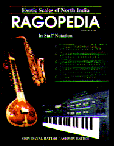
In order to evoke the proper mood or Rasa a performer has to very skillfully manipulate specific tones of the Raga only then can the true image or feeling blossom.To achieve such a state of consciousness, the definition and understanding of notes and their relation to the root (tonic) note - the intensity of effect meant to be produced by their usage and employment in the manipulation of respective Ragas through various phrases, embellishments, and other forms of melodic self expression - is essential. By following and maintaining the value of these notes in regular practice, a wide variety of emotional sound values becomes possible.
Vadi: Sonant note is the note of primary importance. In most cases it is also the note most frequently struck. Thus it helps in evoking the Rasa to its fullest, acting like a beacon to show the path. It is also called the life note. Different notes determined as Vadi notes can express different emotions at various times of the day and night. A Vadi note is often addressed as the king.
Samvadi: Subsonant note. This is the second most important note of a Raga and is the second most frequently struck note in its melodic expansion. In most cases the Vadi and Samvadi notes are a fourth or fifth apart. It is often addressed as a wazir.
Anuvadi: Assonant note. The notes in a Raga that are neither Vadi or Samvadi are called its Anuvadi notes. They are often addressed as companion or attendant notes.
Vivadi: Dissonant note. It is a note which should not be used in a Raga. As an exception however, it is used by skillful musicians in an implied form in order to enhance the beauty of the Raga. Vivadi notes are often addressed as enemy notes.
So the analogy goes that the musical kingdom comprises the King (Vadi note) accompanied by his wazir (Samvadi note) with his attendants (Anuvadi notes.) Naturally he has to watch out for the enemy (Vivadi) notes. Just as a king enhances his prestige by over-throwing and over powering his enemies, in the same manner the prestige of a musician is enhanced by dexterous use of the Vivadi note in the melodic expansion of the Raga.
